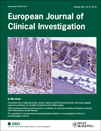Measurement of nasal nitric oxide by hand-held and stationary devices
Abstract
Eur J Clin Invest 2011; 41 (10): 1063–1070
Background Nasal nitric oxide (nNO) is assessed by nasal aspiration/insufflation via one nostril or by nasal silent exhalation through a facemask and is also measured during humming, a manoeuvre that results in increased nNO in the presence of a patent osteomeatal complex. Humming nNO peak is absent in primary ciliary dyskinesia (PCD) and in cystic fibrosis (CF). Hand-held devices are used successfully for exhaled or nNO analysis. No study compared nNO during silent and humming exhalation using hand-held and stationary analysers.
Methods Thirty-eight subjects (14 PCD; 11 CF; 13 healthy individuals) measured nNO with a stationary and a hand-held analyser during silent and humming exhalations.
Results No difference between nNO obtained from stationary or hand-held analyser during silent and humming exhalation was found (P > 0·05). Patients with PCD exhibited lower silent and humming nNO than CF or controls (P < 0·001). During both silent and humming exhalation, there was a significant correlation between nNO from the two analyzers both in the whole study population and within each group (r ≥ 0·7, P < 0·01). Bland–Altman plots confirmed this agreement. Using the hand-held device during humming, nNO values of 50, 81 and 21 ppb had sensitivity and specificity > 90% for discriminating PCD or CF from healthy subjects, and patients with PCD from patients with CF, respectively.
Conclusions The hand-held device is as effective as the stationary analyzer for assessing nNO during silent and humming exhalation. Its wider use might result in an increased number of subjects suspected to have PCD.




